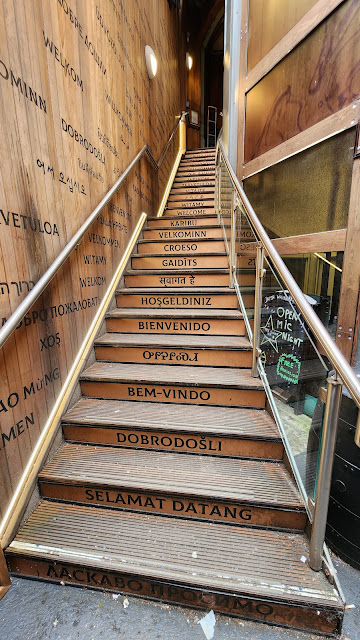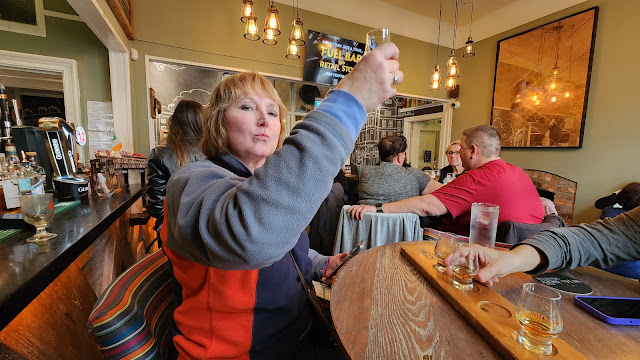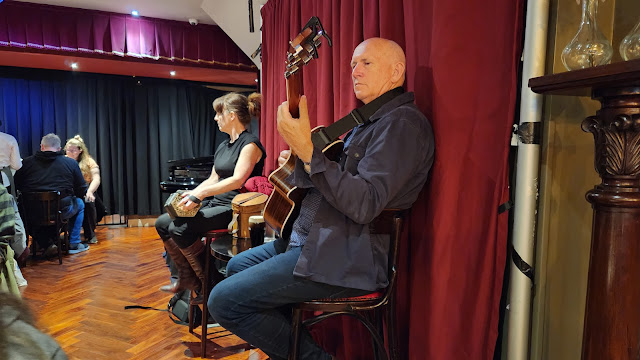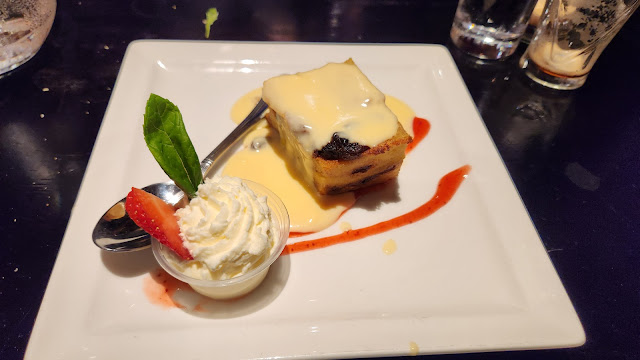(Day nine recap of my late April Ireland trip.)
I know it's weird, but I love visiting old cemeteries. There's so much history that can be found from perusing ancient tombstones. However, during my 9 days in Ireland I'd been seeing lots of graveyards and was getting cemeteried-out. So on our second day in Dublin, when I saw a visit to Glasnevin Cemetery on the agenda, I initially wasn't very excited. Of all the interesting places to see in Dublin they're taking us here?
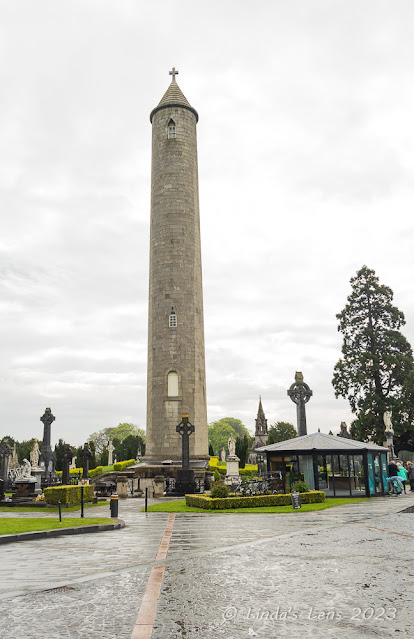 |
| Daniel O'Connell Tower |
One of the great things about not having to travel far, our tour group got to sleep in that morning and wasn't required to report until 9 am. Since our original bus driver George had finished his driving duties and headed home, we had a new bus and driver for our day's trip. Sadly, George's brand-new bus had us spoiled because the bus we rode to Glasnevin was a well-used and dirty vehicle. But luckily today's drive was short - only 45 minutes and we were pulling into the cemetery's gate.
 |
| Graves of priests |
The first thing I noticed about Glasnevin Cemetery was the tall stone tower that soared high above the grounds. Built to honor the famous Irish Liberator Daniel O'Connell, this tower lies directly over his grave. At 180 feet (or 55 meters) it is still one of the highest structures in Dublin.
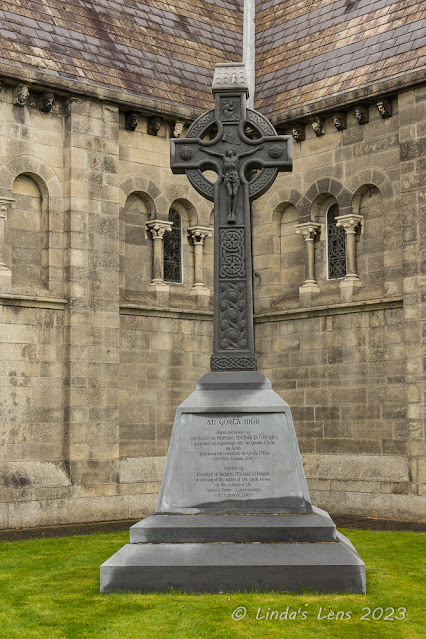 |
| Large Celtic cross next to the chapel |
Daniel O'Connell was the key figure in the Catholic Emancipation Movement of 1829. Because of his perseverance, many of the Catholic restrictions imposed by the Penal Laws were removed. He became known as the Liberator, and continued to represent the people of Ireland, advocating for a separate Irish Parliament in Dublin.
 |
| Thick rows of trees line this lane |
Glasnevin Cemetery owes its origins to Daniel O'Connell. The English Penal Laws didn't allow Catholics to be buried in the Protestant cemeteries. As part of his work to advance the rights of Catholics, O'Connell established the Dublin Cemeteries Committee to provide dignified burial space "for those of all religions and none." In 1832 Glasnevin became the second cemetery opened by this committee. Glasnevin was established to accept burials of all faiths and all people, regardless of income (and it still does to this day).
 |
| Cross close-up - so much detail! |
After disembarking from our bus, my fellow tour-mates and I wandered around the cemetery's entrance area. It was a dreary, rainy morning so we all flipped up our hoods or unfurled umbrellas. The ornate tombstones were fascinating! Most were adorned with crosses of every design, while some supported full size statues of religious figures. There were so many graves packed into this place, the headstones were nearly on top of each other. While waiting for our guide I roamed around with my camera, snapping copious images.
 |
| Graves are packed in here |
There were Celtic crosses of all shapes and sizes. And some of them were quite tall - as you see in the photo below:
 |
| Some of these crosses are quite tall! |
After 10 minutes of self-exploration, our tour guide arrived and introduced himself. His name was Niall ("like the river" he quipped) and he was a middle-school history teacher who volunteered at the cemetery on weekends.
 |
| Our guide Niall was fantastic |
We were soon to discover Niall was a wealth of information, not only about the cemetery but all things relating to Irish history.
 |
| Niall was a wealth of information |
Glasnevin Cemetery covers 124 acres and contains the graves of many of Ireland's most prominent national figures. As well as famous names, nearly 800,000 people have been buried in unmarked mass graves, victims of the great potato famine of the 1840s and a later cholera epidemic.
 |
| Chapel and crosses |
While Niall was giving us some introductory information, a friendly crow landed on an adjacent kiosk rooftop. It was so close, I couldn't resist snapping a couple of pics.
 |
| A friendly crow |
After a brief overview of Glasnevin Cemetery, Niall led us to the most important grave of them all, the burial crypt of Daniel O'Connell.
 |
| Entering Daniel O'Connell's tomb |
Located at O'Connell's tower base, the crypt itself was sunk below cemetery level. Access was down a set of stairs. O'Connell's crypt was encircled by a moat. The moat's inner side had doorways set into the rock wall. Niall said each of these housed coffins from several other important Irish families.
 |
| Around this tomb was a moat, with separate rooms for coffins |
At the tower's base was a door that led to Daniel O'Connell's tomb itself. Niall unlocked the door and ushered us inside. The place was ornately decorated. The walls and ceiling painted in flowery patterns, the floor a tile mosaic with shamrocks.
 |
| The ornate tomb of Daniel O'Connell |
A carved stone structure protected O'Connell's coffin. However, there were several holes in the structure and through the openings one could get a glimpse of the simple wooden coffin in which Daniel O'Connell was buried.
 |
| There were holes so one could touch the actual coffin - said to bring good luck |
Niall said it was good luck to touch O'Connell's coffin. Several of us reached inside the holes to stroke his wooden box. Of course I touched it too - who couldn't use a bit of good luck?
 |
| An adjacent room held coffins of the O'Connell family |
There was a small room off to the side of Daniel O'Connell's crypt that held four coffins, stacked haphazardly on top of each other. Niall said these held members of the O'Connell family. Didn't look like a very dignified way to bury somebody.
 |
One last look at Daniel O'Connell's tomb
|
At the end of his life Niall said that Daniel O'Connell traveled on a pilgrimage to Rome. On this journey he became ill and died in Genoa Italy. His famous deathbed quote was "My body to Ireland, my soul to heaven, and my heart to Rome." In accordance with his wishes, O'Connell's heart was buried in Rome while the rest of his body was transported back to Ireland and buried here at Glasnevin.
 |
| I loved the tile mosaic design on the floor |
My tour-mates and I enjoyed being able to see the inside of Daniel O'Connell's crypt. I don't think the general public is allowed in there, so that made our tour doubly special.
 |
| The cemetery was beautifully landscaped |
Exiting the crypt, the rain kicked in again, but that didn't deter our tour group. We followed Niall past a section of the cemetery where priests and bishops were buried. The priests all had grave markers of simple black stone while the more ornate tombs housed important clergy, like bishops and cardinals.
 |
| One of the many columbarium walls at Glasnevin |
Niall led us by a section of Glasnevin reserved for holding cremated remains of loved ones. This columbarium contained several colorful walls that housed ashes.
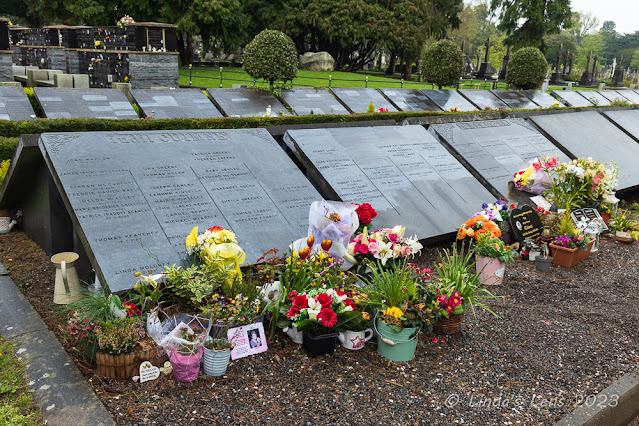 |
| Another columbarium site |
There were also large family plots at ground level that contained cremated remains. Many of these areas were covered with colorful flowers.
 |
| Lovely statues adorning these graves |
Beyond the columbarium Niall led us past a large grassy mound, encircled by an iron fence. In the middle of the area sat a large stone with the word "Parnell" chiseled on it.
 |
| Charles Parnell's grave |
This was the grave of Charles Stewart Parnell, a famous Irish politician who served as a member of Parliament in the late 1800's. Although he achieved many victories for the Irish people, an adulterous affair, which was a huge scandal in those times, sullied his name. Parnell is buried on top of a mass grave containing cholera victims.
 |
| Walking down one of the lanes |
There were lots of huge trees in this area, and it was a very beautiful and restful part of the cemetery.
 |
| Stopping at Eamon de Valera's grave |
Our next stop was at the grave of Eamon de Valera. Another important Irish political figure, this man was prominent in the 1916 Easter Rising and later became the first president of Ireland.
 |
de Valera's grave
|
Niall had so many interesting stories about the history of Glasnevin. My favorite was when he pointed to the tall stone wall that surrounded the cemetery and asked if we knew why the wall was built. The answer surprised us - it was due to grave robbers.
 |
| O'Connell tower rises high above the graves |
In the 18th and early 19th centuries medical schools were in search of cadavers for their students to dissect. They paid such good money for bodies that it inspired crooks to rob graves. To deter the bodysnatchers, Glasnevin constructed a tall wall with watchtowers and employed several watchmen to roam the cemetery at night with bloodhounds.
 |
| I liked this statue of Mary |
The best story from Niall: In the late 1800s, a man's wife suddenly died. He tried to remove her wedding ring, but it wouldn't come off her finger. So she had to be buried with her ring. The grave robbers got wind of this, and that night unearthed her coffin. The crooks decided to cut her finger off to get the ring. As they were trying to do this, the woman awakened. Apparently she wasn't dead at all - and had only been in a very deep coma. Her sudden resurrection scared the bodysnatchers and they ran off. The woman wandered back to her home. When her husband answered the door and discovered his wife, bloody and very much alive, he had heart attack and died. The man was then buried in his wife's grave.
 |
| Wide-angle view |
As we wandered through the many gravesites on our tour, the rain slowly let up. After visiting Eamon de Valera's grave, the sun started peeking through the clouds, flooding the cemetery with nice light.
 |
| There were all sorts of decorations on the headstones |
We passed by the tomb of James Larkin, Ireland's famous labor leader (and whose statue on O'Connell Street had been my favorite.) For such a famous man his tombstone was very plain, simply a large block of unadorned concrete.
 |
| James Larkin grave |
There were so many crosses in Glasnevin! Most were quite ornate and nearly all of Celtic design.
 |
| Twin Celtic crosses |
The final stop on our guided tour was the grave of Michael Collins. A famous Irish revolutionary, soldier and politician, he was a central figure in the early 20th century struggle for Irish independence.
 |
| Michael Collins grave |
Michael Collins led one of two national paramilitary groups that launched the 1916 Easter Rising. After being captured during this uprising and spending time in jail, Michael was released. He then organized another military group to fight for Irish independence. Collins was in charge of intelligence, and trained many soldiers in guerilla warfare tactics. After the 1921 ceasefire Michael was sent to London to negotiate a peace treaty. Not everyone was happy with the terms he came back with, and a group in opposition (led coincidentally by Eamon de Valera) splintered off and fanned the flames of civil war. In 1922, Michael was shot and killed in an ambush by anti-treaty forces. He was only 31 years old. A recent movie that does an excellent job of portraying this man's life and heroism is Michael Collins, starring Liam Neeson.
 |
| People from all over the world leave flowers on Michael Collins' grave |
Michael Collins is still respected worldwide, and Niall remarked that people from all over visit his grave and leave flowers and other items. There is one anonymous person that sends flowers weekly, and has done this for several years.
 |
| Very interesting gravesite (I thought) |
After paying our respects to Michael Collins, our guided tour was over. We all sadly bid Niall a fond farewell. He had been such a fantastic guide! A wealth of historical knowledge and interesting tales, Niall was an excellent storyteller who had kept us engaged the entire time. His enthusiasm for Irish history was contagious. My tour-mates and I all agreed Niall's students were lucky to have such a wonderful teacher.
 |
| Rows upon rows of tombstones |
After parting with Niall, our group had another half hour to roam the premises and check out anything a second time.
 |
| And more headstones.... |
Lucky for me, blue sky started chasing the clouds away. Time to get more photographs with all this good light!
 |
| The sun finally came out at our tour's end |
I couldn't get over how tightly packed all the gravesites and headstones were placed. But this chaos made for some interesting images. I never imagined cemeteries could be so photogenic!
 |
| Lines of Celtic crosses |
Enjoy a few more random photos.....
 |
| Interesting statue |
 |
| The tiniest angel |
I'd glimpsed this tiny angel statue on a tombstone near de Valera's grave, but neglected to photograph it at the time. Upon completion of the tour, I wandered back through the rows of headstones to find the sculpture again. There weren't any inscriptions on the adjacent tomb, so I can only assume it was to commemorate someone's young child taken way too early.
 |
| Flowers for a loved one |
There were several small, but touching memorials left beside many graves.
 |
| One last look... |
Although initially skeptical about visiting yet another Irish cemetery I thoroughly enjoyed my tour of Glasnevin. So much history in this place! And we'd had such a phenomenal guide, he had really enhanced everything with his insights and stories. It was definitely a worthwhile activity.
 |
| Our tour group photo |
Our Rick Steves tour guide Pascal had been trying all week to get a group photo, but during every tour someone had been missing. On this last day everyone was finally present, so Pascal lined us up in front of the O'Connell Tower and recruited our bus driver for photographic duty.
Departing from Glasnevin, Kim and I now had the afternoon free to explore more of Dublin. When planning our Ireland trip, one place had been first and foremost on our minds to visit - the Guinness Storehouse! That's where we were headed after lunch. Come back for my next post and read all about our Guinness experience.








































































